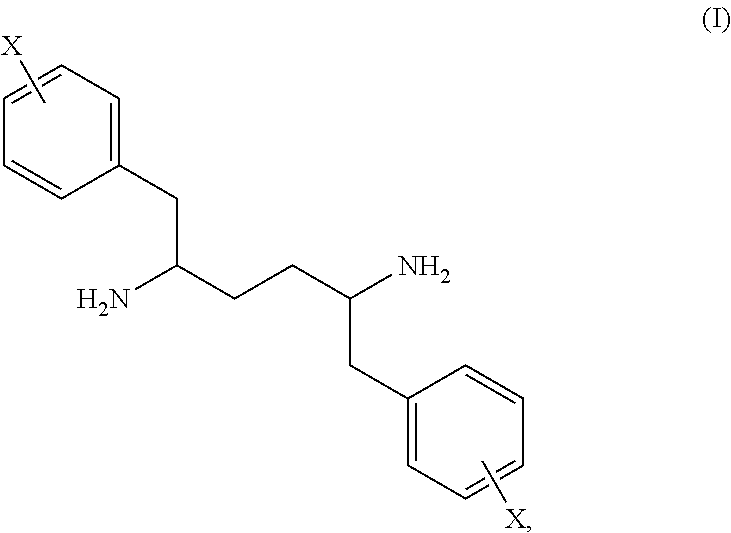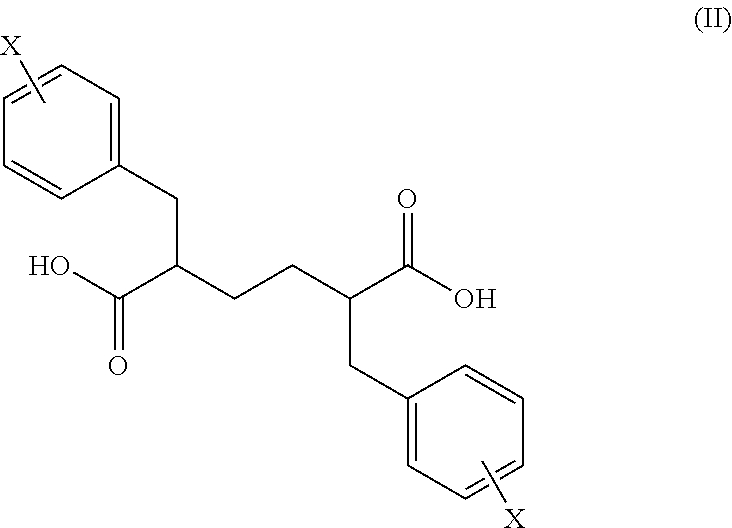Novel stereoisomeric mixtures, synthesis and uses thereof
a technology of stereoisomeric mixtures and mixtures, applied in the field of new stereoisomeric mixtures, can solve the problems of high cost of commercial processes, unwanted side products usually accompanying use, and high cost of chiral aziridines, and achieve cost and processing advantages, promote the bis-decarboxylative bis-amination reaction, and broaden the practical avenue of synthesis
- Summary
- Abstract
- Description
- Claims
- Application Information
AI Technical Summary
Benefits of technology
Problems solved by technology
Method used
Image
Examples
example 1
Synthesis of diethyl-2,5-dibenzylhexanedioic acid
[0115]
[0116]In a 20 L jacketed reactor, NaOEt (632 g) was suspended in 5200 mL THF and heated to 60° C. Diethyl hexanedioic acid (1520 g) was added slowly, maintaining an internal temperature≦65° C. The approximate addition time was 50 min. The mixture was stirred for 16 h at 60° C. Benzyl chloride (1066 g) was added over 3.75 h. The mixture was stirred at 60° C. for 3.5 h then cooled to 22° C. Additional NaOEt (635 g) was added over 2 h, heated to 60° C., and stirred for 16 h. Benzyl chloride (1143 g) was added over 1.75 h. The mixture was heated to 65° C. for 6 h and then cooled to 30° C. NaOEt (130 g) was added and the mixture heated to 60° C. for 5 h to convert the ring closed cyclopentanone intermediate to the desired open chain form. Benzyl chloride (269 g) was added over 1.75 h and the mixture stirred at 60° C. for 2 h to convert any unreacted NaOEt to benzyl ethyl ether. Ethanol (291 g) was added and the mixture was cooled to ...
example 2
Synthesis of 2,5-dibenzylhexanedioic acid
[0118]
[0119]In a jacketed reactor, 500 g of diethyl-2,5-dibenzylhexanedioic acid (DBA) was suspended in 650 mL of MeOH. Water was charged (150 mL) followed by addition of solid KOH (220 g). The approximate addition time was 20 min, such that the internal temperature was ≦60° C. After the addition was complete, the system was fitted with a reflux condenser and heated to 60° C. for 12 h. Upon reaction completion, the reflux condenser was replaced with a distillation head. Solvent was stripped under house vacuum (15-20 in Hg) to yield 500 mL of a thick slurry. MTBE (500 mL) and water (500 mL) were charged, the mixture stirred, and was allowed to settle. The aqueous layer was transferred to a jacketed reactor and cooled to 0° C. 37% HCl (390 g) was charged slowly over 50 min, maintaining an internal temperature of ≦10° C., to form a solid precipitate. The solid was filtered, washed with water (300 mL), and dried. 2,5-dibenzyladipic acid was isola...
example 3
Synthesis of 1,6-diphenylhexane-2,5-diamine
[0121]
[0122]In a jacketed reactor, 2,5-dibenzylhexanedioic acid (225 g) and Et3N (147 g) were dissolved in 1.5 L of toluene. A minimal precipitate was observed and the mixture was filtered to remove the solids. The filtrate was returned to the reactor and cooled to 5° C. DPPA (398 g) was charged over 20 min. A moderate exotherm was observed (internal temperature≦15° C.). The mixture was stirred at 5° C. for 6 h, warmed to 22° C., and held for 12 h (minimal bubbling was observed). The mixture was heated to 50° C., held for 3 h, and returned to 22° C. This diisocyanate mixture was transferred to an addition funnel. To the reactor was charged LiOH (145 g) and water (2 L). This solution was cooled to 5° C. whereupon the diisocyanate mixture was added at a rate of 25 mL / min. Upon complete addition, the mixture was warmed to 22° C. where a white precipitate formed (Li dicarbamate). To a separate reactor, 37% HCl (900 g) was charged and cooled to ...
PUM
| Property | Measurement | Unit |
|---|---|---|
| Electrical conductance | aaaaa | aaaaa |
| Stereoisomer | aaaaa | aaaaa |
Abstract
Description
Claims
Application Information
 Login to View More
Login to View More - R&D
- Intellectual Property
- Life Sciences
- Materials
- Tech Scout
- Unparalleled Data Quality
- Higher Quality Content
- 60% Fewer Hallucinations
Browse by: Latest US Patents, China's latest patents, Technical Efficacy Thesaurus, Application Domain, Technology Topic, Popular Technical Reports.
© 2025 PatSnap. All rights reserved.Legal|Privacy policy|Modern Slavery Act Transparency Statement|Sitemap|About US| Contact US: help@patsnap.com



